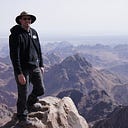Psalm 23: The Lord Is My Shepherd — Part IX
The Bible says, “The fear of the Lord is the beginning of wisdom” (Proverbs 1:7). The 23rd psalm teaches us, “The fear of the Lord,” may also be the, “beginning of comfort.”
It is said, humans are “creatures of comfort.” Simply put, given the choice between discomfort and comfort, you can probably guess which choice we will veer towards. This is a sentiment, rightly or wrongly, I can easily identify with. However, when we think about comfort in relationship to this particular phrase from psalm 23, there are two things we should immediately find perplexing:
First, the items mentioned, “the rod and the staff,” do not actually belong to us, they belong to the shepherd. When I think of my own personal comfort, I generally do not consider what others possess, rather I ponder what I already possess or long to possess. I think about my black leather recliner; I think about a hot cup of coffee first thing in the morning; I think of a warm a blanket on a cold winter’s morning. Why should another’s possessions give me comfort?
Secondly, and more puzzling still, are the instruments of the shepherd that give comfort — a walking stick and a club? Why would these two items give comfort to a sheep? If anything, these items should be understood as items of fear not comfort.
“Thy Rod” — As we think of a Palestinian shepherd, one can hardly imagine a shepherd without his long staff with its rounded crook. The shepherd and his staff are as synonymous as the shepherd is to his sheep. Everyone knows about the staff, but equally important was the shepherd’s rod. In contrast to the staff, the rod, or more accurately a club, was a short piece of carved hardwood, usually between one to two feet in length, with a rounded and gnarled nob at its top. The rod had three primary purposes for the shepherd and his sheep: First, it was the shepherd’s primary weapon, which he would use to fend off predators,* and in a less dramatic sense, was also a handy tool to give swift correction to an out of line sheep. Secondly, the rod was extremely important for communication. When a shepherd was leading his sheep through treacherous mountain passes, where the sheep following from behind would be out of eye sight of their leader, the shepherd would continuously use his rod to strike the mountainside, giving his sheep a clear sound to follow. Finally, the rod was the shepherds symbol of authority. The Hebrew word for “rod” is the same word translated as sceptre. The rod was the symbol of authority for both a nation’s king,** and for the patriarchal head of a family. Likewise, the rod as a tool of protection and correction, consistently reminded the sheep, who was the boss.
“Thy Staff” — The most distinguishable aspect of the shepherd’s staff was its hooked end. The staff, and specifically its crook, was a very useful tool to the shepherd and the sheep. The staff was a faithful support to the shepherd, helping with the many long wonderings amidst uneven, rocky grounds. The crook is quite an ingenious aspect of the staff, serving two primary purposes, one obvious and the second less so: First, as one can easily guess, the crook served as a very practical tool to pull sheep away from one another; even from a distance the shepherd could remove a troublemaker quickly from the fray. The second benefit was both in the staff’s height and in its distinguishable top. The staff generally stood a couple feet taller than the shepherd, and with its unique hook, it served as a consistent and visible reminder to the sheep of the location of their master.
In our current day and climate we have grown accustomed to distrust those wielding authority and power. We often question whether instruments of power will be used to protect or to coerce submission. Powerful tools in the wrong hands can quickly lead to abuse and tyranny. However, the same powerful tools in the hands of the good and perfect Shepherd, help us recognize, they will never be used in haste, and even when used for our own correction, we are assured it is always and only for our benefit. The rod that nudges us in the right direction is also the club that fends off the attacking jackal. The long staff that pulls us away from danger is also the flagpole that indicates our guardian is close at hand.
- *Note # 1 — When considering the famous encounter of David with Goliath in 1 Samuel 17, David tells king Saul how he defeated both a lion and a bear when it attacked his father’s sheep. As a kid, I always assumed, because of David’s proficiency with a sling, it was the sling that was his primary weapon in defeating these two beasts. However, upon a closer reading of the narrative, it is clear that David referred to beating the animals with a rod not a sling. “When a lion or bear came and carried off a sheep from the flock, I went after it, struck it and rescued the sheep from its mouth. When it turned on me, I seized it by its hair, struck it and killed it” (34–35).
- **Note # 2 — In a previous post I highlighted how both the rod and the staff (or the “crook and the flail”) were also the symbols of kingship: https://www.trentsidechurch.ca/about-us/blog/the-lord-is-my-shepherd-part-one-1/
